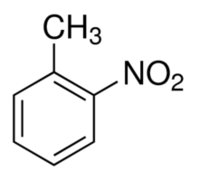Difference between revisions of "2-Nitrotoluene"
| Line 1: | Line 1: | ||
| − | |||
{{Chembox | {{Chembox | ||
| Name =2-nitrotoluene | | Name =2-nitrotoluene | ||
| Line 8: | Line 7: | ||
| OtherNames = o-nitrotoluene | | OtherNames = o-nitrotoluene | ||
<!-- Images --> | <!-- Images --> | ||
| − | | ImageFile = 2-nitrotoluene_structure.png | + | | ImageFile = 2-nitrotoluene_structure-2.png |
| ImageSize = | | ImageSize = | ||
| ImageAlt = | | ImageAlt = | ||
| Line 106: | Line 105: | ||
| OtherFunction = | | OtherFunction = | ||
| OtherFunction_label = | | OtherFunction_label = | ||
| − | | OtherCompounds = 3-nitrotoluene<br>4-nitrotoluene<br>[[Trinitrotoluene]] | + | | OtherCompounds = [[3-nitrotoluene]]<br>[[4-nitrotoluene]]<br>[[Trinitrotoluene]] |
}} | }} | ||
}} | }} | ||
| Line 117: | Line 116: | ||
===Physical=== | ===Physical=== | ||
| − | 2-nitrotoluene is a yellow, oily liquid. It has a strong | + | 2-nitrotoluene is a yellow, oily liquid. It has a strong odor resembling almonds, typical of nitrated aromatic compounds. |
==Availability== | ==Availability== | ||
| Line 127: | Line 126: | ||
==Projects== | ==Projects== | ||
| − | *Make indigo | + | *Make [[indigo]] |
*Make di- and trinitrotoluene | *Make di- and trinitrotoluene | ||
| Line 138: | Line 137: | ||
===Disposal=== | ===Disposal=== | ||
| − | 2- | + | 2-nitrotoluene can be destroyed by burning it. This must be done outside, as burning it will give off soot, carbon monoxide and other harmful fumes. |
| − | 2-nitrotoluene can be safely destroyed with Fenton's reagent. However, it | + | 2-nitrotoluene can be safely destroyed with Fenton's reagent. However, it is best to add very small amounts of the compound, preferably dilute, as the destruction is exothermic and may aerosolize other aromatic compounds created from the incomplete Fenton oxidation. Using a UV lamp will improve the performance of the neutralization process. |
==References== | ==References== | ||
| Line 151: | Line 150: | ||
[[Category:Organic compounds]] | [[Category:Organic compounds]] | ||
[[Category:Aromatic compounds]] | [[Category:Aromatic compounds]] | ||
| − | |||
[[Category:Nitrated organic compounds]] | [[Category:Nitrated organic compounds]] | ||
[[Category:Liquids]] | [[Category:Liquids]] | ||
Revision as of 20:21, 14 May 2018

| |
| Names | |
|---|---|
| IUPAC name
1-methyl-2-nitro-benzene
| |
| Systematic IUPAC name
1-methyl-2-nitro-benzene | |
| Other names
o-nitrotoluene
| |
| Properties | |
| C6H4CH3NO2 | |
| Molar mass | 137.14 |
| Appearance | Yellow liquid |
| Odor | Weak, aromatic |
| Density | 1.161 g/cm3 (20 °C) |
| Melting point | −10.4 °C (13.3 °F; 262.8 K) |
| Boiling point | 222 °C (432 °F; 495 K) |
| 0.0609 g/100 ml (20 °C) 0.065 m/100 ml (30 °C) | |
| Solubility | Miscible with benzene, carbon tetrachloride, chloroform, diethyl ether, ethanol, petroleum ether |
| Vapor pressure | 0.1 mmHg (20 °C) |
| Hazards | |
| Safety data sheet | Sigma-Aldrich |
| Flash point | 106 °C (223 °F; 379 K) |
| Lethal dose or concentration (LD, LC): | |
| LD50 (Median dose)
|
891 mg/kg (rat, oral) 970 mg/kg (mouse, oral) 1,750 mg/kg (rabbit, oral) |
| Related compounds | |
| Related compounds
|
3-nitrotoluene 4-nitrotoluene Trinitrotoluene |
| Except where otherwise noted, data are given for materials in their standard state (at 25 °C [77 °F], 100 kPa). | |
| Infobox references | |
2-nitrotoluene, also known as o-nitrotoluene, is an isomer of mononitrotoluene. It is a yellow, oily liquid that is slightly more dense than water.
Contents
[hide]Properties
Chemical
Through many different methods, 2-nitrotoluene is oxidized to 2-nitrobenzaldehyde which is a direct precursor to indigo dye.
The nitro group on 2-nitrotoluene may be reduced to yield 2-methylaniline (2-toluidine).
Physical
2-nitrotoluene is a yellow, oily liquid. It has a strong odor resembling almonds, typical of nitrated aromatic compounds.
Availability
Nitrotoluenes are not available in any consumer products due to being toxic and possibly carcinogenic, and are not found in nature.
Preparation
A mixture of mononitrotoluene isomers can be prepared from the nitration of toluene between -10º and 30º C. Lower temperatures result in little or no reaction, while higher temperatures will result in double nitration forming dinitrotoluenes.
Relevant thread: Preparation of Mononitrotoluenes (o-, p-)
Projects
- Make indigo
- Make di- and trinitrotoluene
Handling
Safety
2-nitrotoluene is quite toxic and a suspected carcinogen. It must be handled with care, and should be used only in a fume hood. Care should be taken to avoid inhaling its vapors.
Storage
A glass bottle with a tight fitting, chemical resistant cap is sufficient for containing 2-nitrotoluene. For better safety, store the bottle inside of another larger container to limit exposure.
Disposal
2-nitrotoluene can be destroyed by burning it. This must be done outside, as burning it will give off soot, carbon monoxide and other harmful fumes.
2-nitrotoluene can be safely destroyed with Fenton's reagent. However, it is best to add very small amounts of the compound, preferably dilute, as the destruction is exothermic and may aerosolize other aromatic compounds created from the incomplete Fenton oxidation. Using a UV lamp will improve the performance of the neutralization process.